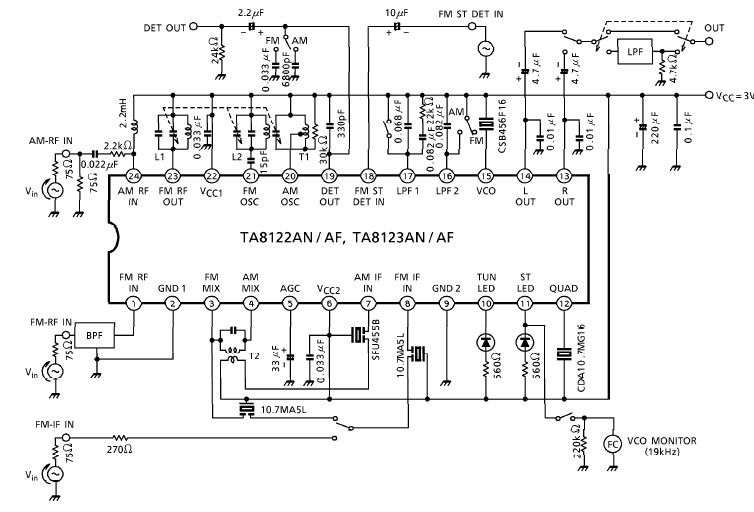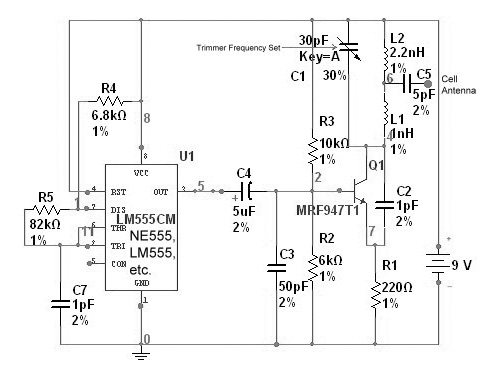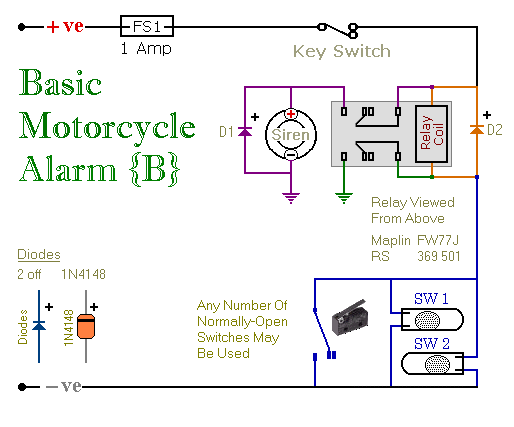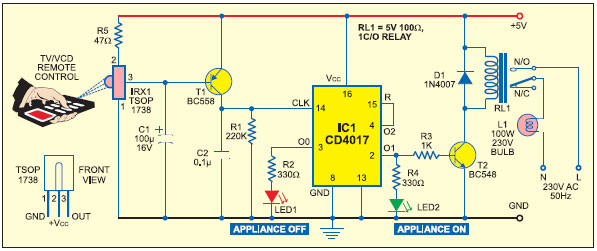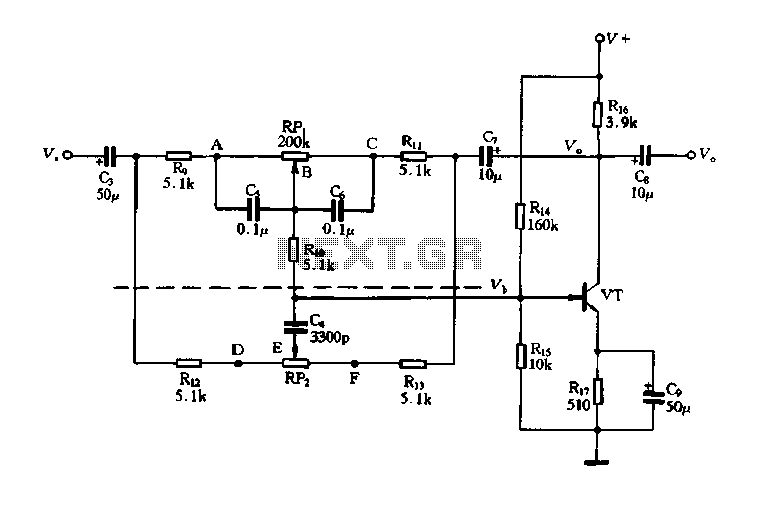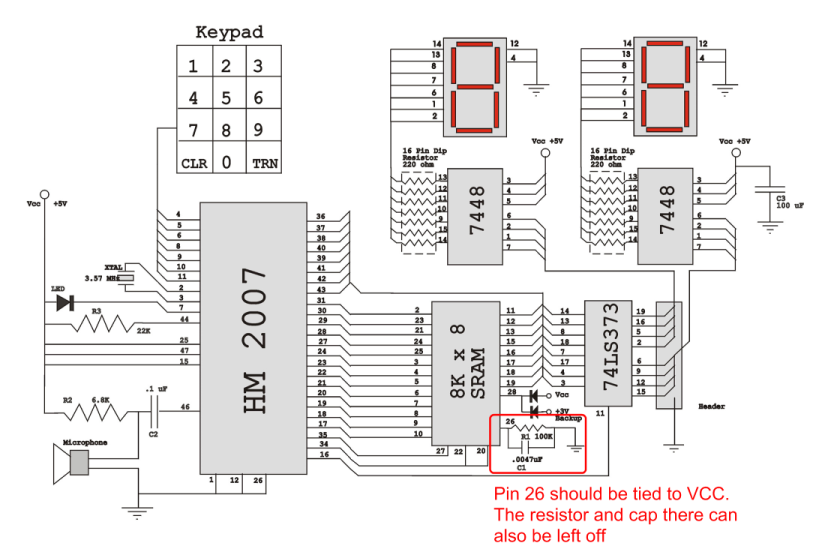
Radio reception circuit diagram TA31136
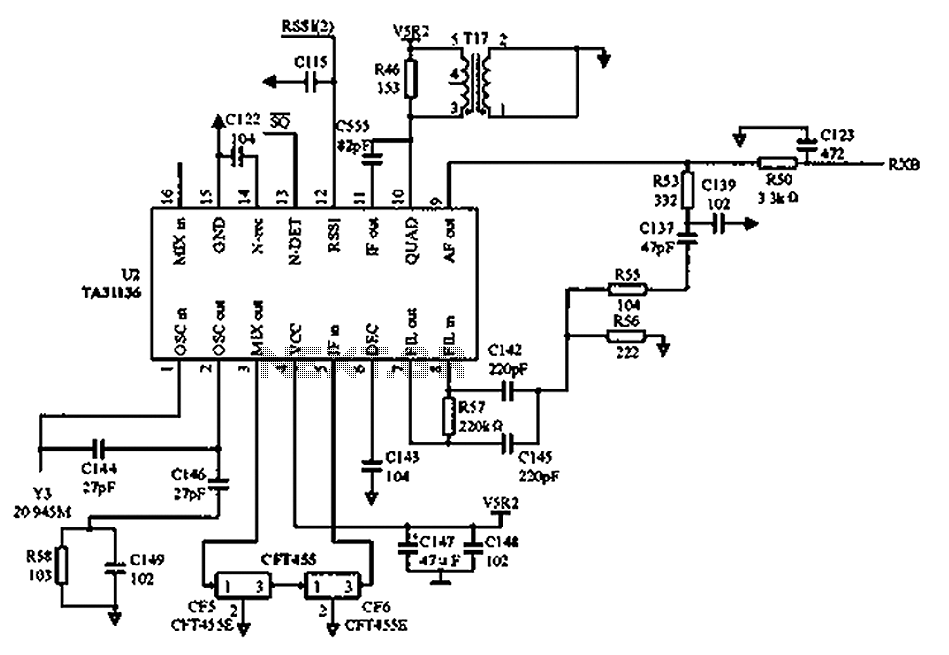
As illustrated in the figure, Vcc is the power supply for the circuit. Upon receiving the initial signal, the frequency is adjusted to 21.7 MHz. This frequency is subsequently enhanced through two crystal filters to improve the selectivity of the input signal. T10 is tuned to resonate at 21.7 MHz and is part of the selected frequency amplifier using transistor Q2. VCC2 is set at 5 V, providing the necessary bias voltage to the transistor. The U3 component (TA31136) processes the 21.7 MHz input signal at pin 16 in conjunction with a 21.245 MHz local oscillator signal at pin 1, resulting in a second intermediate frequency of 455 kHz. The intermediate frequency (IF) amplifier then utilizes this 455 kHz signal, where a frequency discriminator demodulates the signal. The output is then passed through a low-pass filter, which is composed of resistor R64 and an external capacitor C116, to filter the intermediate frequency and suppress high harmonics, thereby producing a low-level circuit output. The circuit also incorporates a frequency discriminator at pins 10 and 11, although debugging the coil proved challenging. Consequently, a switch was made to the Murata ceramic frequency CDB450C24, which features a simple structure, ease of implementation, a frequency accuracy of ±1%, a bandwidth of approximately 10 kHz, and does not require load capacitance.
The circuit operates primarily at a frequency of 21.7 MHz, which serves as the main signal frequency. The use of crystal filters is critical in enhancing the selectivity, allowing for the rejection of unwanted frequencies and ensuring that the desired signal is amplified effectively. The transistor Q2 plays a pivotal role in amplifying the selected frequency, and the bias voltage supplied by VCC2 ensures optimal operation of the transistor within its active region.
The TA31136 integrated circuit (U3) is designed for radio frequency applications and is utilized here to mix the 21.7 MHz signal with a local oscillator frequency of 21.245 MHz. This mixing process generates an intermediate frequency of 455 kHz, which is a common frequency used in various communication systems for further processing. The IF amplifier stage is crucial for amplifying the 455 kHz signal before it is demodulated by the frequency discriminator.
The demodulation process involves extracting the original information signal from the modulated carrier wave. The low-pass filter composed of resistor R64 and capacitor C116 effectively removes high-frequency components, allowing only the desired low-frequency signals to pass through, which is essential for producing a clean output signal.
The switch to the Murata ceramic frequency CDB450C24 highlights the importance of component selection in circuit design. The CDB450C24 offers advantages such as compactness, ease of integration, and reliable frequency stability, which are essential for maintaining performance in demanding environments. This choice reflects a thoughtful approach to optimizing the circuit's functionality and reliability. As shown in FIG, Vcc to the circuit is V power supply. After receiving the first signal frequency becomes 21.7 MHz, 21.7 MHz and then after two crystal filter to enhance the se lectivity of the input signal. T10 is the resonant frequency of 21.7 MHz in the week, and the composition of the selected frequency amplifier transistor Q2. VCC2 is 5 V, may provide a bias voltage to the transistor. U3 (TA31136) to 21.7 MHz input signal 16 feet with 1 foot of 21.245 MHz local oscillator signal for mixing, to form a second intermediate frequency 455 kHz.
And then the IF amplifier from 455 kHz frequency discriminator in the week out of the demodulated signal through a low pass filter formed by resistor R64 and the internal composition of the external capacitor C116, filtered intermediate frequency and high harmonics into the low-level circuit. The program before 10 feet and 11 feet out of the part using a frequency discriminator in the week, and found the week coil difficult to debug, and later switched to Muratas ceramic frequency CDB450C24.
Because CDB450C24 simple structure, easy to implement, frequency accuracy of plus or minus 1%, the bandwidth of about 10 kHz, and does not require the load capacitance.
The circuit operates primarily at a frequency of 21.7 MHz, which serves as the main signal frequency. The use of crystal filters is critical in enhancing the selectivity, allowing for the rejection of unwanted frequencies and ensuring that the desired signal is amplified effectively. The transistor Q2 plays a pivotal role in amplifying the selected frequency, and the bias voltage supplied by VCC2 ensures optimal operation of the transistor within its active region.
The TA31136 integrated circuit (U3) is designed for radio frequency applications and is utilized here to mix the 21.7 MHz signal with a local oscillator frequency of 21.245 MHz. This mixing process generates an intermediate frequency of 455 kHz, which is a common frequency used in various communication systems for further processing. The IF amplifier stage is crucial for amplifying the 455 kHz signal before it is demodulated by the frequency discriminator.
The demodulation process involves extracting the original information signal from the modulated carrier wave. The low-pass filter composed of resistor R64 and capacitor C116 effectively removes high-frequency components, allowing only the desired low-frequency signals to pass through, which is essential for producing a clean output signal.
The switch to the Murata ceramic frequency CDB450C24 highlights the importance of component selection in circuit design. The CDB450C24 offers advantages such as compactness, ease of integration, and reliable frequency stability, which are essential for maintaining performance in demanding environments. This choice reflects a thoughtful approach to optimizing the circuit's functionality and reliability. As shown in FIG, Vcc to the circuit is V power supply. After receiving the first signal frequency becomes 21.7 MHz, 21.7 MHz and then after two crystal filter to enhance the se lectivity of the input signal. T10 is the resonant frequency of 21.7 MHz in the week, and the composition of the selected frequency amplifier transistor Q2. VCC2 is 5 V, may provide a bias voltage to the transistor. U3 (TA31136) to 21.7 MHz input signal 16 feet with 1 foot of 21.245 MHz local oscillator signal for mixing, to form a second intermediate frequency 455 kHz.
And then the IF amplifier from 455 kHz frequency discriminator in the week out of the demodulated signal through a low pass filter formed by resistor R64 and the internal composition of the external capacitor C116, filtered intermediate frequency and high harmonics into the low-level circuit. The program before 10 feet and 11 feet out of the part using a frequency discriminator in the week, and found the week coil difficult to debug, and later switched to Muratas ceramic frequency CDB450C24.
Because CDB450C24 simple structure, easy to implement, frequency accuracy of plus or minus 1%, the bandwidth of about 10 kHz, and does not require the load capacitance.
Warning: include(partials/cookie-banner.php): Failed to open stream: Permission denied in /var/www/html/nextgr/view-circuit.php on line 713
Warning: include(): Failed opening 'partials/cookie-banner.php' for inclusion (include_path='.:/usr/share/php') in /var/www/html/nextgr/view-circuit.php on line 713
